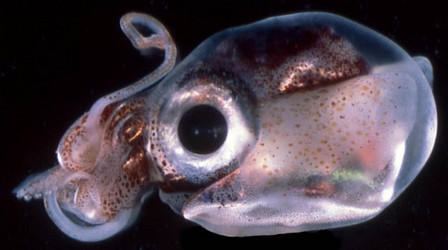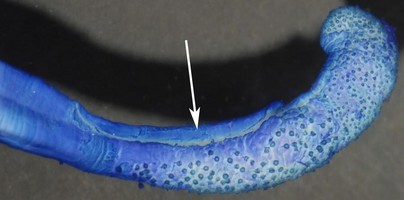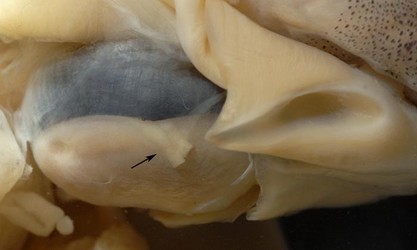Iridoteuthis
Richard E. Young and Michael Vecchione- Iridoteuthis iris (Berry, 1909)
- Iridoteuthis sp. A
Introduction
Iridoteuthis is similar in appearance to Stoloteuthis and Amphorateuthis. The genus contains two species, one of which is unnamed. The discovery of the second species has allowed us to better define the genus. Like all heteroteuthins, members of the genus are small and colorful. The best known and most distinctive species is I. iris known from Hawaiian waters.
Brief diagnosis:
A heteroteuthin with ...
- mantle broadly fused to head dorsally.
- funnel locking-apparatus having a curved groove with deep, angular pit.
Characteristics
- Arms
- Oral surfaces of arm bases, proximal to suckers, in females, covered with small papillae.
- Aboral surfaces of arms in both sexes with distal, expanded, tough, membranous keels (= flags).
- Arms III in males without enlarged sucker(s).
 Click on an image to view larger version & data in a new window
Click on an image to view larger version & data in a new window

Figure. Left - Oral view of the papillate areas at the bases of the arms (upper arrow - arm III, lower arrow - arm I) in female Iridoteuthis sp. A. Middle - Oral-lateral view of arm III tip, I. iris, male, showing keel. Right - Ventral view of arms III, I. iris, female, showing keel flags (arrows). Photographs by R. Young.
- Tentacles
- Tentacular club with a tentacular organ that extends well along the sucker-bearing portion of the club.
- Tentacular club with a tentacular organ that extends well along the sucker-bearing portion of the club.
- Funnel
- Funnel locking-apparatus with deep, angular, anterior pit.
 Click on an image to view larger version & data in a new window
Click on an image to view larger version & data in a new window

Figure. Funnel/mantle locking-apparatus of I. iris, Hancock Seamount, 29°46'30"N, 179°03'36"E, NMNH 817723; left in photographs is anterior. Top - Side-oblique view of the mantle component. Bottom - Frontal view of the funnel component. Photographs by M. Vecchione.
- Mantle
- Dorsal mantle broadly fused to head (fusion approximately reaches posterior midpoints of eyes).
- Ventral-mantle shield large (ca. 80% of ventral mantle length); extends nearly to anterior margin of eyes; with strong anterior-medial indentation.
- Mantle with middorsal arch.
- Fins
- Fins with pointed posterior lobes.
- Fins with pointed posterior lobes.
- Photophores
- Visceral photophore papillae each with two large, laterally-visible tubes.
- Photophore tubes located at lateral edges of photophore; do not penetrate photophore "lens" apparently entering glandular photophore between "lens" and ink sac.
Comments
The above generic characteristics are mostly those that separate the genera Iridoteuthis and Stoloteuthis. The other genera are very different from these two and the reader is referred to the Heteroteuthinae page for comparisons of all genera.
Species comparisons
The two species of Iridoteuthis are very different in the sexual modification of the arms (See table below for most striking differences).
| Arms III, males | Arm I, males | Aboral arm flags | Arms III, females | Arms IV, females | |
| Iridoteuthis iris | Mid-arm suckers: dorsal series larger than ventral series | Distal suckers: ventral series larger than dorsal series. Normal protective membranes | Arms I-III | Tips with elongate stalks, no suckers | Tips with elongate stalks, no suckers |
| Iridoteuthis sp. A | Suckers series equal in size | Sucker series equal in size. Elaborate ventral protective membranes | Arms III | Tips without suckers or stalks | Tips with numerous, small suckers |
Distribution
I. iris is known from the Hawaiian Archipelago and Iridoteuthis sp. A from off New Caledonia.
References
Harman, R. F. and M. P. Seki. 1990. Iridoteuthis iris (Cephalopoda: Sepiolidae): New records from the central North Pacific and first description of the adults. Pac. Sci. 44: 171-179.
Young, R. E. 1995. Aspects of the natural history of pelagic cephalopods of the Hawaiian mesopelagic-boundary region. Pacific Science 49: 143-155.
About This Page

University of Hawaii, Honolulu, HI, USA

National Museum of Natural History, Washington, D. C. , USA
Page copyright © 2015 and
 Page: Tree of Life
Iridoteuthis .
Authored by
Richard E. Young and Michael Vecchione.
The TEXT of this page is licensed under the
Creative Commons Attribution-NonCommercial License - Version 3.0. Note that images and other media
featured on this page are each governed by their own license, and they may or may not be available
for reuse. Click on an image or a media link to access the media data window, which provides the
relevant licensing information. For the general terms and conditions of ToL material reuse and
redistribution, please see the Tree of Life Copyright
Policies.
Page: Tree of Life
Iridoteuthis .
Authored by
Richard E. Young and Michael Vecchione.
The TEXT of this page is licensed under the
Creative Commons Attribution-NonCommercial License - Version 3.0. Note that images and other media
featured on this page are each governed by their own license, and they may or may not be available
for reuse. Click on an image or a media link to access the media data window, which provides the
relevant licensing information. For the general terms and conditions of ToL material reuse and
redistribution, please see the Tree of Life Copyright
Policies.
- Content changed 26 December 2007
Citing this page:
Young, Richard E. and Michael Vecchione. 2007. Iridoteuthis . Version 26 December 2007 (under construction). http://tolweb.org/Iridoteuthis/20032/2007.12.26 in The Tree of Life Web Project, http://tolweb.org/












 Go to quick links
Go to quick search
Go to navigation for this section of the ToL site
Go to detailed links for the ToL site
Go to quick links
Go to quick search
Go to navigation for this section of the ToL site
Go to detailed links for the ToL site